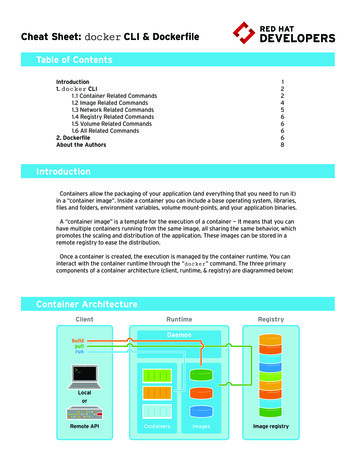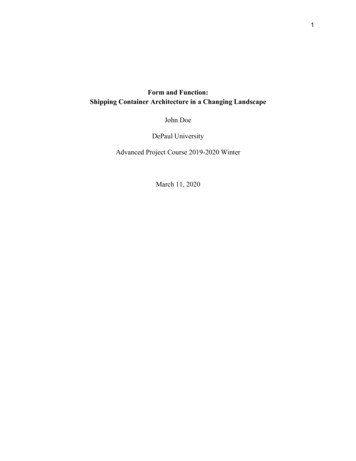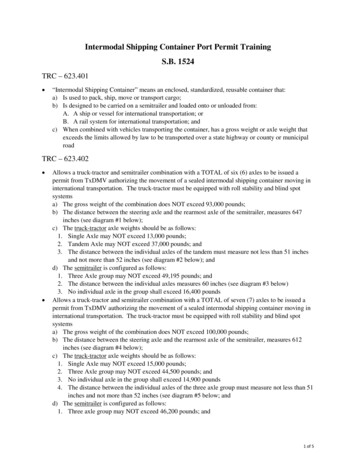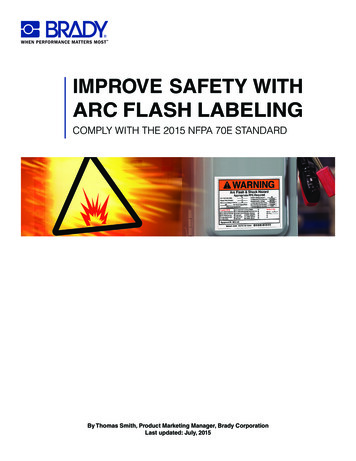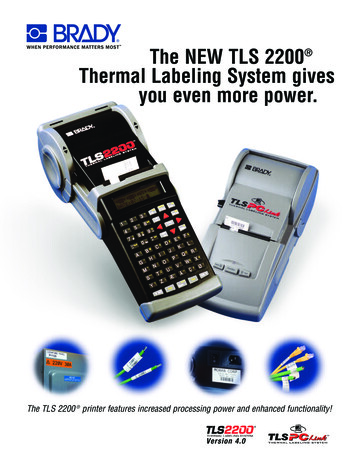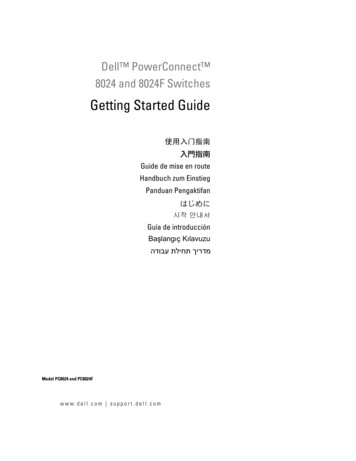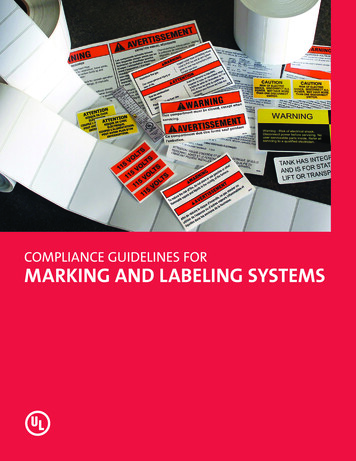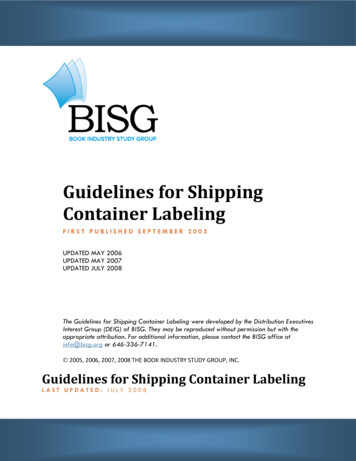
Transcription
Guidelines for ShippingContainer LabelingFIRST PUBLISHED SEPTEMBER 2005UPDATED MAY 2006UPDATED MAY 2007UPDATED JULY 2008The Guidelines for Shipping Container Labeling were developed by the Distribution ExecutivesInterest Group (DEIG) of BISG. They may be reproduced without permission but with theappropriate attribution. For additional information, please contact the BISG office atinfo@bisg.org or 646-336-7141. 2005, 2006, 2007, 2008 THE BOOK INDUSTRY STUDY GROUP, INC.Guidelines for Shipping Container LabelingLAST UPDATED: JULY 2008
Guidelines for Shipping Container LabelingLast Updated:July 2008Table of ContentsINTRODUCTION .4Compliance and Definition of Terms . 4SHIPPING LABEL .5Shipping Label Layout. 5Shipping Label Size . 5Shipping Label Placement . 6Top Labeling . 6Side Labeling . 7UPS Shipping Label Template . 8Returns . 9PRODUCT LABEL.10Product Label Layout . 10Product Label Size . 10Zoned Product Information . 10Zone 1 . 11Zone 2 . 11Zone 3 . 12Special Note on the ISBN Transition to 13-Digit Format . 13Special Note on Bar Coding the ISBN in Zone 3 . 13Product Label Placement. 13PRODUCT LABEL CERTIFICATION PROGRAM .14Certification – Process Overview. 14Certification Elements . 15Certification – Application Process. 15Certification – Results. 16CARTON MARKING RECOMMENDATIONS .17MULTI-VOLUME SETS .18Set is a Small Number of Volumes . 18Product Label for a carton containing several sets . 19All Volumes of a Set Are Packed in and Fill a Single Carton . 20Example Labels for a Carton Containing a Single Set . 21Specifications for Carton Top Label. 22Set Requires More Than One Carton . 23Example Labels for a Set Requiring More than One Carton. 24Illustration of Labels for a Set Requiring Three Cartons . 25Page 2The Book Industry Study Group (BISG)
Guidelines for Shipping Container LabelingLast Updated:July 2008ADDITIONAL RESOURCES .26APPENDIX A: SHIPPING LABEL EXAMPLES .27APPENDIX B: SHIPPING LABEL PLACEMENT EXAMPLES .37APPENDIX C: PRODUCT LABEL EXAMPLES .39APPENDIX D: DATA DEFINITIONS AND ENCODING .46APPENDIX E: CALCULATIONS .54Page 3The Book Industry Study Group (BISG)
Guidelines for Shipping Container LabelingLast Updated:July 2008INTRODUCTIONThe DEIG Guidelines for Shipping Container Labeling (“DEIG Guidelines”) have been developed andrevised through the work of the Book Industry Study Group’s Distribution Executives Interest Group(DEIG).The DEIG Guidelines represent the Book Industry Study Group’s best practices recommendations forthe creation and placement of Shipping Labels, Product Labels and Carton Marking. By adhering to therecommendations in these guidelines the book industry will simplify the capturing of data at all stagesof shipping, warehousing and receiving physical product between publishers, distributors andbooksellers.The DEIG Guidelines also serve to align the book industry with global trade generally.The DEIG Guidelines conform to ANSI/UCC-6: Application Standard for Shipping Container Codespublished by GS1 US and are to be used as a basis for more specific agreements on shipping containerlabeling between trading partners. To purchase the ANSI/UCC-6: Application Standard for ShippingContainer Codes visit http://productcatalog.gs1us.org/.It is expected that the DEIG Guidelines will be revised and updated as new standards are developedboth within and outside of the book industry and to keep up with emerging technologies. Users ofthese guidelines are encouraged to provide feedback so that future updates can benefit from userexperience.Compliance and Definition of TermsCompliance with all standards developed by the Book Industry Study Group is voluntary and subjectto agreement between participating trading partners.The following terms are used throughout this document only in relation to compliance with theDEIG Guidelines. There is no intent to dictate or otherwise affect terms of trade between tradingpartners.Must – Statements using the word “must” describe conditions that must be present for an action orpractice to be in compliance with the DEIG Guidelines.Should – Statements using the word “should” describe conditions that are recommended as goodpractice in the spirit of the DEIG Guidelines.May – Statements using the word “may” describe options available within the DEIG Guidelines.Page 4The Book Industry Study Group (BISG)
Guidelines for Shipping Container LabelingLast Updated:July 2008SHIPPING LABELThe Shipping Label contains information relevant to a specific shipment. BISG has adopted the mostcurrent standards of the GS1-128 label format as the basis for shipping label standards in the bookindustry. Updates to the DEIG Guidelines will be considered as changes are made to the GS1standards.Shipping Label LayoutThe layout of the GS1-128 label consists of different zones, each a separate building block. The sizeof the zones, with the exception of certain zones that have mandatory dimensions, can be adjustedto accommodate varying amounts of information. Even when zones are resized, however, theplacement of information must remain consistent relative to the information in other zones. Inother words, there is flexibility in placing the information within zones, but the sequence of zonesmust be preserved.Shipping Label SizeZone Height – Each zone must measure 1.0″ in height 0.2″. However, a zone may be doubled inheight to accommodate additional information. The height of the double-high zone is 2.0″ in height 0.4″. Please note that Zone H when present must always be 2.0″ 0.4″ to accommodate the SSCC18 bar code.Zone Width – The width of the zones is determined by the width of the label. In some cases, thelabel width can be divided to accommodate two zones side by side.Label Height – The recommended minimum label height is 6.0″. The height of the label can be tallerif necessary to accommodate additional information. However, the sequence of zones must bepreserved and the placement guidelines described below must be observed.Label Width – The recommended minimum label width is 4.0″. The label may be wider if necessaryto accommodate additional information.Examples:The layouts shown in Appendix A are examples compliant with the DEIG Guidelines; they are notindustry standards as such.Figure A-1 shows a sample of the zone layout of a 4.0″ x 6.0″ GS1-128 label with all fields beingutilized and with Zones A through H at a 1.0″ height and Zone I at its mandatory 2.0″ height.Figure A-2 shows a sample of the zone layout of a 4.0″ x 7.0″ GS1-128 label again where Zones Athrough H are 1.0″ in height, Zone I is at 2.0″ in height and where Zones E and F are expanded to thefull width of the label causing the label size to change to 7.0″. Examples of Common Carrier(Truckload/LTL), “mark-for” and small parcel labels also appear in Appendix A.Page 5The Book Industry Study Group (BISG)
Guidelines for Shipping Container LabelingLast Updated:July 2008Table D-1 in Appendix D defines the uses, sizes and mandatory or minimum requirements for thedifferent zones on the shipping label. Whenever information located in Zones E through I on theshipping label is to be bar coded, it must be based on Code GS1-128 symbology. Symbology in ZonesC and D must meet carrier requirements. Where there is no specific carrier requirement, Code GS1128 symbology should be used as the symbology in Zones C and D. Code GS1-128 is a variant ofCode 128. Its use is exclusively licensed by GS1 US (www.gs1us.org).Experienced bar code vendors, including those identified athttp://www.bisg.org/barcoding/bc suppliers.html are knowledgeable regarding thesespecifications.Shipping Label PlacementThe original DEIG Guidelines called for the Shipping Label to be placed on the top of the carton. Thecurrent GS1 US “Application Standards for Shipping Container Codes” calls for the placement of theShipping Label on the side of the carton. To accommodate both top and side labeling, as well asprovide guidelines for those that are transitioning from top to side or both, these revised DEIGGuidelines contain standards for each.Ultimately, the placement of Shipping Labels will be agreed to by trading partners based on theneeds and abilities of both the shipper and receiver. However, it is recommended that asenhancements to shipping or receiving operations are planned, the ability to utilize both side- andtop-label be considered.Top LabelingShipping Labels placed on the top of the carton must adhere to the following general guidelines(examples are provided in Appendix B, Figure B-1): Page 6The Shipping Label must be placed so it does not cover the seam of the carton. If placed onthe seam, the label could be damaged when the carton is opened or bar codes could bedistorted by the seam.The Shipping Label must be placed in such a way that the tape used in sealing the cartondoes not cover any bar code or other critical information on the Shipping Label.Ideally, the Shipping Label should be placed so that no bar code, particularly that of theSSCC, appears any closer than 1¼″ from any natural edge of the carton.The Book Industry Study Group (BISG)
Guidelines for Shipping Container LabelingLast Updated:July 2008For small cartons where the top surface does not allow for all of the above guidelines to befollowed, the exceptions below are allowed: The Shipping Label should be placed on top of any sealing tape.If the Shipping Label is placed in a manner in which the SSCC bar code will appear closerthan 1¼” to the edge and side of the top of the carton, the label should be placed in such away that the SSCC bar code is placed away from the short edge of the carton so that thequality of the bar code is not diminished if the corner of the carton is damaged.If the Shipping Label must be placed across the seam of the carton, care must be taken thatno bar code or other critical information crosses the seam and could be lost when thecarton is opened.Side LabelingIn keeping with the guidelines set forth by the GS1 US “Application Standards for Shipping ContainerCodes,” Shipping Labels placed on the side of the carton must meet the following criteria (examplesare provided in Appendix B, Figure B-2): Shipping Labels must be placed on the long side of the carton with the bar codes in a verticalbar or “picket fence” orientation. In order to achieve this picket fence orientation, mostlabels will need to be placed straight up and down.Shipping Labels must be placed in such a way that the SSCC bar code appears no closer than1¼″ from the natural bottom of the carton.The Shipping Label must be placed so that the SSCC bar code appears no closer than 1¼″from the edge of the carton.If the Shipping Label is placed on the same side of the carton as a Product Label it must beplaced to the left side of the Product Label so that it does not obscure any of theinformation on the Product Label and so that no bar code appears closer than 1¼″ from thenatural edge of the carton. (See example under Figure B-3 in Appendix B.)For cartons where the height of the carton is less than that of the Shipping Label, one of thefollowing must occur: Page 7The entire Shipping Label may be placed on the top of the carton following the guidelinesfor Top Labeling.ORThe shipping label may be placed on the side of the carton with the bottom of the bar codeplaced at least 1¼″ from the natural bottom; and the excess portion of the top of the labelshould be folded over to the top of the carton. Care must be taken in these cases to notcrease the Shipping Label on any bar codes or other critical information.The Book Industry Study Group (BISG)
Guidelines for Shipping Container LabelingLast Updated:July 2008UPS Shipping Label TemplateIn cooperation with the Book Industry Study Group, UPS has developed a template for a ShippingLabel compliant with the UPS shipping label standards while leaving room to accommodate theinformation recommended in the DEIG Guidelines.To allow for all of the information to appear on the shipping label, UPS has reduced their typicallyrecommended height requirement for the Tracking Number bar code from 1.0″ to 0.75″.Additionally, UPS has agreed to change many of the font sizes typically required. A sample of theUPS shipping label template can be found in Appendix A under Figure A-5. The specificationspertaining to fonts and bar code heights must be adhered to for acceptance by UPS.In addition, BISG has developed two further templates that have been approved by UPS for use witha 4.0″x 6.0″ and 4.0″x 7.0″ Shipping Label where the Ship To and Ship From addresses appear side byside, more closely resembling the Shipping Label standards for other carriers. These templates canbe found under Figures A-6 and A-7 in Appendix A. While these templates were developed for theindustry as a whole, it remains the responsibility of each company using them to obtain appropriatecertification from UPS. Companies should reference the “BISG Layout” when corresponding withUPS during the certification process.Whereas the general recommendation for bar coding the Shipping Label is based on GS1-128symbology, Shipping Labels prepared for UPS must utilize Code-128 symbology for UPS specific barcodes. Bar codes appearing in Zones E though I must still be based on GS1-128 (UCC/EAN – 128)symbology. Please refer to the “UPS Guide for Labeling” (available from UPS representatives) forexact specifications.Care must be taken to use the correct Application Identifier (AI) codes and data construction asoutlined in Appendix D, Table D-3, of this document. Table D-4 defines font sizes and bar codeheights specific to the BISG Layout for the UPS label. For information on the creation of theMaxiCode, Routing codes, bar code symbologies and other UPS-related information, the latestversion of the “UPS Guide to Labeling” should be consulted.Page 8The Book Industry Study Group (BISG)
Guidelines for Shipping Container LabelingLast Updated:July 2008ReturnsThe recommendations outlined above for Shipping Labels can also be used for the shipment ofreturns back to the vendor. In these cases, the information contained in Zone E (Receiver/CustomerSegment) would be information required by the receiver of the return. Additionally, Zone F(Shipper/Supplier Segment) would be reserved for internal information that the shipper of thereturns may require.There have been additional Application Identifiers (AIs) assigned specifically for use with returns;these can be found in Table D-3 in Appendix D.An alpha code has been designated to identify the return product type; this information would belocated in Zone E of the Shipping Label. Additional information on the use of this code can be foundin Table D-1 in Appendix D. Samples of Shipping Labels used for returns can be found in Appendix Aunder Figures A-8, A-9 and A-10.Page 9The Book Industry Study Group (BISG)
Guidelines for Shipping Container LabelingLast Updated:July 2008PRODUCT LABELThe Product Label contains information relevant to the contents of the carton but not to the particularshipment. In an effort to minimize the duplication of information on the Shipping and Product Label,and to eliminate the need to print two labels at the time of shipment, the following standards must beused when labeling or marking product information on full carton packs only. It is impossible togenerate a Product Label for a mixed carton pack.GS1-128 (UCC/EAN-128) symbology must be used for all bar codes observing the correct ApplicationIdentifiers (AIs) as outlined in Table D-3 in Appendix D.Note: With the emergence of new technology and the continued need for title marketing, it isunderstood that labeling may not be the only method for identifying the contents of a carton.Product Label LayoutThe Product Label follows an approach similar to that of the Shipping Label and is composed ofzones. The height of the zones can be adjusted to accommodate varying amounts of information.However, the sequence of the zone layout, the sequence of information within each zone, and thebar code minimum specifications must be preserved.Product Label SizeLabel Height – The recommended minimum product label height is 4.0″.Label Width – The recommended minimum product label width is 6.0″.Zone Height – The recommended Zone Height for Zones 1 & 2 is 1.0″and for Zone 3 is 2.0″ on astandard 4.0″x 6.0″ label.Zone Width – The width of the zones will be the width of the label less borders.Zoned Product InformationThe following explains the various zones, or order, in which the product information must be placedon a Product Label. Table D-2 in Appendix D shows the various zones and a more detailed listing ofsome of the items that would be included in the various zones. The correct AI prefixes and dataconstruction for bar coded information are contained in the list in Appendix D, Table D-3.Page 10The Book Industry Study Group (BISG)
Guidelines for Shipping Container LabelingLast Updated:July 2008Zone 1This zone, the first block of information to appear on a Product Label, contains human readable nonbar coded information specific to the product. Typically, and to eliminate repeated information, thisfield includes information that is not otherwise bar coded on the carton.All human readable information with the exception of the title must be printed at a minimum 12ptfont. The title must be printed at a minimum 14pt Bold font.Required information for Zone 1 includes: Title or Product DescriptionPublisherCountry of OriginOptional information for Zone 1 includes: AuthorOn-Sale Date -- The date before which a retailer may not offer the book for sale, oftenreferred to as “strict on sale date”.Technical Information for Media Products -- Depending on the product this could becassette, DVD, CD, etc.In cases where bar coded information is not being directly printed on the carton but is on a separatelabel, text for bar coded information may also appear in this zone.Zone 2The second zone, the middle block of information on a Product Label, is reserved for publisherspecific information, which may or may not be bar coded depending on the need of the publisher.This information could include the publisher purchase order, printing number and Cover 4 bar codedesignation.When showing the Cover 4 bar code designation, the following abbreviations must be utilized: EAN,UPC or E/U if the title has both an EAN and UPC on Cover 4. Note, however, that dual bar codes arenot compliant with BISG Policy Statement POL-0701on products shipped March 31, 2008 or later.See BISG Policy Statement POL-0701 (http://www.bisg.org/documents/policies.html) for moreinformation on the elimination of dual identifiers.When placing a bar coded purchase order number in Zone 2, the proper AI (251) must be used andidentified by either PPON (Publisher Purchase Order Number) or similar text. This approach isnecessary in order to clearly identify the data as the publisher’s order number to the manufacturerand not the customer’s purchase order number to the publisher, which is located on the ShippingLabel.Page 11The Book Industry Study Group (BISG)
Guidelines for Shipping Container LabelingLast Updated:July 2008Zone 3The last zone, the bottom section of information on the Product Label, is reserved for bar codedproduct information that is equally useful to both the shipper and the receiver.Required data elements for Zone 3, to be correctly encoded in the bar code symbology, are: ISBN -- See “Special Note on Bar Coding the ISBN in Zone 3” below for information ondisplaying the human readable ISBN.Carton QuantityCarton WeightCover Price (suggested list price)The data elements listed above should appear in the order shown in the various examples inAppendix C.Print quality of the bar codes used in Zone 3 must meet or exceed GS1 recommended minimumsand all type fonts must be in compliance. See www.gs1us.org.When books do not display a cover or suggested list price, the following bar code conventions mustbe used:For items that have no price – (e.g., free promotional material) – “0000USD" must be encoded inthe bar code, preceded by the 9012Q Application Identifier. "COVER PRICE: 00.00 USD" must beprinted above the bar code. For example:For items that are net priced – (i.e., items which do not display a suggested retail price) –“ NETUSD” must be encoded in the bar code, preceded by the 9012Q Application Identifier. "COVERPRICE: NET USD" must be printed above the bar code. For example:In cases where printing directly on the carton would not create acceptable bar codes, thisinformation must be labeled at the bottom of the carton, taking care not to obstruct otherinformation and maintaining a minimum distance from the bottom or edge of the carton of at least1¼″. When printing the human readable price above the bar code symbol, it should be preceded bya dollar sign ( ) as shown in the examples above.Page 12The Book Industry Study Group (BISG)
Guidelines for Shipping Container LabelingLast Updated:July 2008Special Note on the ISBN Transition to 13-Digit FormatThe ISBN was officially redefined from a 10-digit identifier to a 13-digit identifier on January 1, 2007.As a result, the human readable ISBN printed above the ISBN bar code on the Product Label must bedisplayed in the current 13-digit format. Note that there is no change in the data encoded in the barcode.The proper display of the human readable ISBN is: ISBN 978-1-4028-9462-6. The transitionterminology of “ISBN-13” should no longer be used.It is acceptable, during the latter stages of the transition, for a publisher to display the legacy ISBN10 format when the publisher finds that the market requires it. The legacy ISBN-10 may bedisplayed either above or below the current ISBN and it should be labeled as “ISBN-10” when it isdisplayed.Details regarding the transition to ISBN-13 can be found on the BISG website at www.bisg.org.Special Note on Bar Coding the ISBN in Zone 3Although the human readable ISBN printed above the bar code on a Product Label is shown in 13digit format, it must continue to be encoded in the bar code as a 14-digit identifier utilizing GS1-128(UCC/EAN-128) symbology. This identifier, also known as GTIN-14, includes the Application Identifier“01” and requires a recalculated check digit as described in Table D-3.It is recommended that unless a publisher/supplier has specifically assigned package levelidentifiers, the unofficial general retailing convention of using "1" to indicate the case levelpackaging should be followed. When the publisher/supplier has specifically assigned package levelidentifiers to various carton configurations, the identifier associated with a particular carton mustconform to those assignments.Product Label PlacementProduct Labels must be placed at least 1¼″ from any carton edge or in such a manner that bar codeson the label do not appear closer than 1¼″ from any carton edge. If using wrap-around labels, theymust be printed and applied so the bar codes do not appear closer than 1¼″ from the top andbottom or other edge of the carton.Product Labels must appear on at least two sides of the carton, one of which must be the long sideof the carton.Product Label bar codes must be in a vertical bar or “picket fence” configuration.Page 13The Book Industry Study Group (BISG)
Guidelines for Shipping Container LabelingLast Updated:July 2008PRODUCT LABEL CERTIFICATION PROGRAMBISG has established a Product Label Certification Program (PLCP) as a means to achieve the benefitsof widespread use of the Product Label by facilitating the implementation process. The BISG programprovides convenient and efficient validation of shippers’ label implementations and assurance torecipients that the labels comply with the specifications of the previous section.BISG’s Product Label Certification Program: Promotes implementation of the label through shipper education, implementation supportand comprehensive feedback of non-compliance issues;Minimizes the number of potentially redundant certification or evaluation processes towhich labels must be submitted; andEnsures recipients that certified Product Labels are in technical compliance with DEIG andGS1 guidelines, thus:o Reducing the time a recipient must spend certifying shippers’ labelso Reducing the in-house technical expertise required of recipients in label formattingand bar codingThe greatest value the Product Label Certification Program provides is in assisting label submitters, notin serving in a testing or policing role. BISG believes that compliant implementation will be achievedmore quickly and perceived as less onerous through easy to understand feedback and suggestions forcorrection when compliance issues arise.Certification – Process OverviewThe BISG office manages the Product Label Certification Program. BISG has contracted with severalprofessional Certification Agencies to perform the technical compliance testing required by theprogram. All Certification Agencies are: GS1 certified bar code suppliersMembers of the Book Industry Study GroupActive members of the Distribution Executives Interest GroupOrganizations seeking certification must submit eight identical printed samples (not photocopies)using the same product data to the BISG office following the procedures outlined athttp://www.bisg.org/documents/certification productlabel.html.Applicants that produce Product Labels in more than one location must submit samples from alllocations to achieve certification under the program.Sample Product Labels must be sent for recertification after changes in warehouse hardware,software, or media that may affect label quality.Page 14The Book Industry Study Group (BISG)
Guidelines for Shipping Container LabelingLast Updated:July 2008Submitted Product Labels will be examined by the BISG office for format and content compliance; alabel non-compliant in any aspect of these areas will be returned to the submitting organizationwith a non-compliance report for correction before the certification process proceeds.Product labels that are compliant in form
SHIPPING LABEL . The Shipping Label contains information relevant to a specific shipment. BISG has adopted the most current standards of the GS1-128 label format as the basis for shipping label standards in the book industry. Updates to the . DEIG Guidelines. will be considered as changes are made to the GS1 standards. Shipping Label Layout
